Biology - Chapter 5: Fundamental Unit of Life
1/36
Earn XP
Description and Tags
Name | Mastery | Learn | Test | Matching | Spaced |
|---|
No study sessions yet.
37 Terms
Nucleus membrane [NUCLEUS]
The nucleus has a double layered covering called the nuclear membrane
The nuclear membrane has pores which allow the transfer of material from inside the nucleus to its outside, that is, the cytoplasm
Chromosomes [NUCLEUS + DNA]
They are visible as rod shaped structure only when the cell is about to divide
Chromosomes contain information for the inheritance of characters from parents to the next generation in the form of DNA molecules.
Chromosomes are composed of DNA and protein.
DNA molecules
contain the information necessary for constructing and organizing cells. Functional
segments of DNA are called genes. In a cell
which is not dividing, this DNA is present as
part of chromatin material. Chromatin
material is visible as entangled mass of thread
like structures. Whenever the cell is about to
divide, the chromatin material gets organised
into chromosomes.
Cellular Reproduction
The nucleus plays a central role in cellular reproduction, the process by which a single cell divides and forms two new cells.
It also plays a crucial part, along with the environment, in determining the way the cell will develop and what form it will exhibit at maturity, by directing the chemical activities of the cell.
Nuclear region in prokaryotes [PROKARYOTES]
In some organisms like bacteria, the nuclear region of the cell may be poorly defined due to the absence of a nuclear membrane. Such an undefined nuclear region containing only nucleic acids is called a nucleoid.
Such organisms, whose cells lack a nuclear membrane, are called prokaryotes
(Pro = primitive or primary; karyote ≈ karyon = nucleus).
Prokaryotes
Prokaryotic cells also lack most of the other cytoplasmic organelles present in eukaryotic cells, that is in prokaryotes, beside the absence of a defined nuclear region, the membrane-bound cell organelles are also absent.
Many of the functions of such organelles are also performed by poorly organised parts of the cytoplasm
The chlorophyll in photosynthetic prokaryotic bacteria is associated with membranous vesicles (bag like structures) but not with plastids as in eukaryotic cells
Diagram of a prokaryotic cell
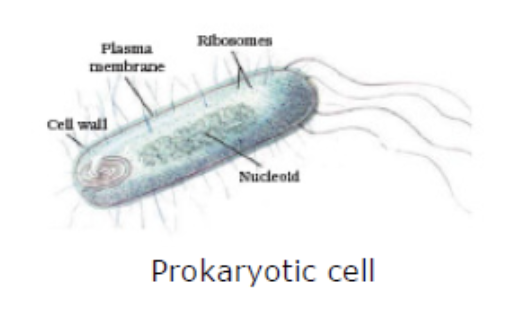
Cytoplasm
The cytoplasm is the fluid content inside the plasma membrane. It also contains many specialized cell organelles. Each of these organelles performs a specific function for the cell.
What is the significance of membranes? Give an example.
The significance of membranes can be illustrated with the example of viruses. Viruses lack any membranes and hence do not show characteristics of life until they enter a living body and use its cell machinery to multiply.
Cell Organelles
Every cell has a membrane around it to keep its own contents separate from the external environment.
Large and complex cells, including cells from multicellular organisms, need a lot of chemical activities to support their complicated structure and function.
To keep these activities of different kinds separate from each other, these cells use membrane-bound little structures (or ‘organelles’) within themselves.
This is one of the features of the eukaryotic cells that distinguish them from prokaryotic cells.
Some of these organelles are visible only with an electron microscope.
Endoplasmic Reticulum
The endoplasmic reticulum (ER) is a large network of membrane-bound tubes and sheets.
It looks like long tubules or round or oblong bags (vesicles). The ER membrane is similar in structure to the plasma membrane.
There are two types of ER– rough endoplasmic reticulum (RER) and smooth endoplasmic reticulum (SER).
RER looks rough under a microscope because it has particles called ribosomes attached to its surface.
The ribosomes, which are present in all active cells, are the sites of protein manufacture. The manufactured proteins are then sent to various places in the cell depending on need, using the ER.
The SER helps in the manufacture of fat molecules, or lipids, important for cell function.
Some of these proteins and lipids help in building the cell membrane. This process is known as membrane biogenesis.
Some other proteins and lipids function as enzymes and hormones.
Thus, one function of the ER is to serve as channels for the transport of materials (especially proteins) between various regions of the cytoplasm or between the cytoplasm and the nucleus.
The ER also functions as a cytoplasmic framework providing a surface for some of the biochemical activities of the cell.
In the liver cells of the group of animals called vertebrates, SER plays a crucial role in detoxifying many poisons and drugs.
Membrane Biogenesis
The SER helps in the manufacture of fat molecules, or lipids, important for cell function.
Some of these proteins and lipids help in building the cell membrane. This process is known as membrane biogenesis.
Animal Cell - Diagram
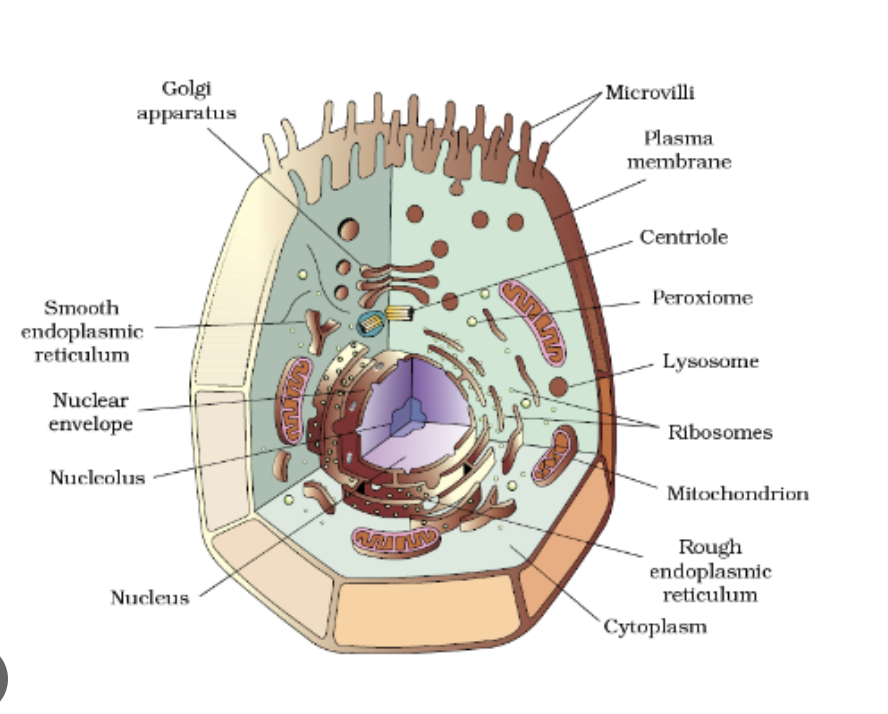
Plant Cell - Diagram
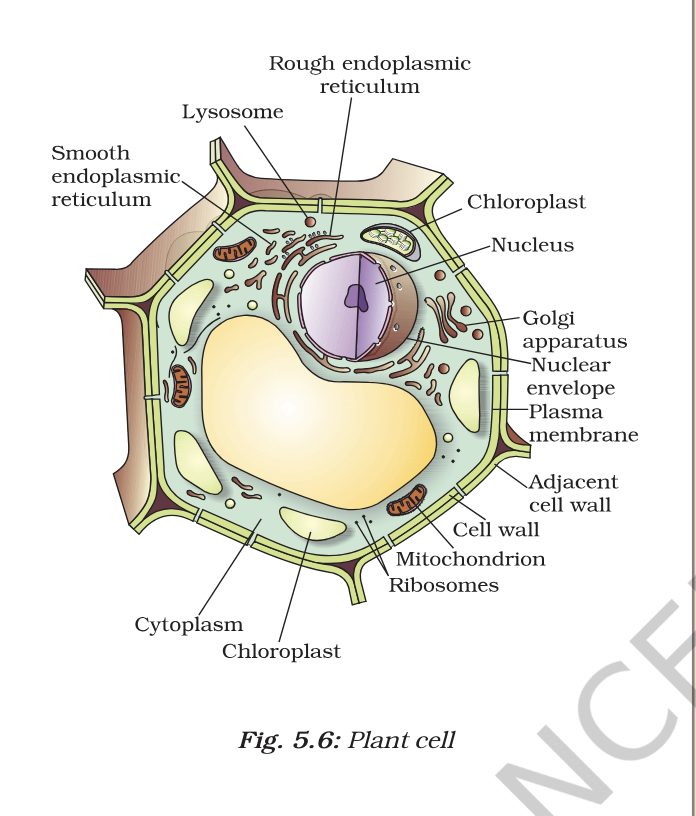
Golgi Apparatus
The Golgi apparatus, first described by Camillo Golgi, consists of a system of membrane-bound vesicles (flattened sacs) arranged approximately parallel to each other in stacks called cisterns.
These membranes often have connections with the membranes of ER and therefore constitute another portion of a complex cellular membrane system.
The material synthesised near the ER is packaged and dispatched to various targets inside and outside the cell through the Golgi apparatus.
Its functions include the storage, modification and packaging of products in vesicles. In some cases, complex sugars may be made from simple sugars in the Golgi apparatus.
The Golgi apparatus is also involved in the formation of lysosomes
Lysosomes
Structurally, lysosomes are membrane-bound sacs filled with digestive enzymes. These enzymes are made by RER.
Lysosomes are a kind of waste disposal system of the cell. These help to keep the cell clean by digesting any foreign material as well as worn-out cell organelles. Foreign materials entering the cell, such as bacteria or food, as well as old organelles end up in the lysosomes, which break complex substances into simpler substances.
Lysosomes are able to do this because they contain powerful digestive enzymes capable of breaking down all organic material.
During the disturbance in cellular metabolism, for example, when the cell gets damaged, lysosomes may burst and the enzymes digest their own cell. Therefore, lysosomes are also known as the suicide bags of a cell.
What is the waste disposal system of the cell?
Lysosomes are a kind of waste disposal system of the cell. These help to keep the cell clean by digesting any foreign material as well as worn-out cell organelles. Foreign materials entering the cell, such as bacteria or food, as well as old organelles end up in the lysosomes, which break complex substances into simpler substances.
Why are lysosomes known as suicide bags?
During the disturbance in cellular metabolism, for example, when the cell gets damaged, lysosomes may burst and the enzymes digest their own cell. Therefore, lysosomes are also known as the suicide bags of a cell.
Define cisterns
The Golgi apparatus, first described by Camillo Golgi, consists of a system of membrane-bound vesicles (flattened sacs) arranged approximately parallel to each other in stacks called cisterns.
Who was the Golgi apparatus first described by?
Camillo Golgi
Mitochondria
Mitochondria are known as the powerhouses of the cell.
Mitochondria have two membrane coverings. The outer membrane is porous while the inner membrane is deeply folded.
These folds increase surface area for ATP generating chemical reactions.
The energy required for various chemical activities needed for life is released by mitochondria in the form of ATP (Adenosine triphopshate) molecules. ATP is known as the energy currency of the cell. The body uses energy stored in ATP for making new chemical compounds and for mechanical work.
Mitochondria are strange organelles in the sense that they have their own DNA and ribosomes. Therefore, mitochondria are able to make some of their own proteins.
What is the full form of ATP? What is its significance in the cell?
The energy required for various chemical activities needed for life is released by mitochondria in the form of ATP (Adenosine triphopshate) molecules.
ATP is known as the energy currency of the cell. The body uses energy stored in ATP for making new chemical compounds and for mechanical work.
The inner membrane of the mitochondria is deeply folded to increase surface for ATP generating chemicals
Why is the mitochondria known as a strange cell?
Mitochondria are strange organelles in the sense that they have their own DNA and ribosomes. Therefore, mitochondria are able to make some of their own proteins.
Plastids
Plastids are present only in plant cells.
There are two types of plastids – chromoplasts (coloured plastids) and leucoplasts (white or colourless plastids).
Chromoplasts containing the pigment chlorophyll are known as chloroplasts. Chloroplasts are important for photosynthesis in plants. Chloroplasts also contain various yellow or orange pigments in addition to chlorophyll.
Leucoplasts are primarily organelles in which materials such as starch, oils and protein granules are stored.
The internal organization of the Chloroplast consists of numerous membrane layers embedded in a material called the stroma. These are similar to mitochondria in external structure.
Like the mitochondria, plastids also have their own DNA and ribosomes.
What are the two types of plastids? { 1 mark }
Chloroplast (colored plastids) and Leucoplasts (white or colorless plastids)
Vacuoles
Vacuoles are storage sacs for solid or liquid contents.
Vacuoles are small sized in animal cells while plant cells have very large vacuoles.
The central vacuole of some plant cells may occupy 50-90% of the cell volume.
In plant cells vacuoles are full of cell sap and provide turgidity and rigidity to the cell.
Many substances of importance in the life of the plant cell are stored in vacuoles.
These include amino acids, sugars, various organic acids and some proteins. In single-celled organisms like Amoeba, the food vacuole contains the food items that the Amoeba has consumed.
In some unicellular organisms, specialised vacuoles also play important roles in expelling excess water and some wastes from the cell.
Differentiate between an animal cell and a plant cell
Animal Cell | Plant Cell |
|---|---|
Outermost covering of the cell is the plasma membrane | Has an another rigid outer covering called the cell wall in addition to the plasma membrane |
Nucleus is centered | Nucleus is located more on the periphery due to the large water filled vacuole in the center of the cell |
Absence of plastids | Plastids are present |
Thus, the cell is the fundamental structural unit of living organisms. It is also the basic functional unit of life.
Each cell thus acquires its structure and ability to function because of the organisation of its membrane and organelles in specific ways. The cell thus has a basic structural organisation. This helps the cells to perform functions like respiration, obtaining nutrition, and clearing of waste material, or forming new proteins.
Cell Division - Define {1 mark}
New cells are formed in organisms in order to grow, to replace old, dead and injured cells, and to form gametes required for reproduction. The process by which new cells are made is called cell division.
Mitosis
The process of cell division by which most of the cells divide for growth is called mitosis.
In this process, each cell called mother cell divides to form two identical daughter cells.
The daughter cells have the same number of chromosomes as mother cell. It helps in growth and repair of tissues in organisms.
Meiosis
Specific cells of reproductive organs or tissues in animals and plants divide to form gametes, which after fertilisation give rise to offspring. They divide by a different process called meiosis which involves two consecutive divisions. When a cell divides by meiosis it produces four new cells instead of just two. The new cells only have half the number of chromosomes than that of the mother cells.
Meiosis - Diagram
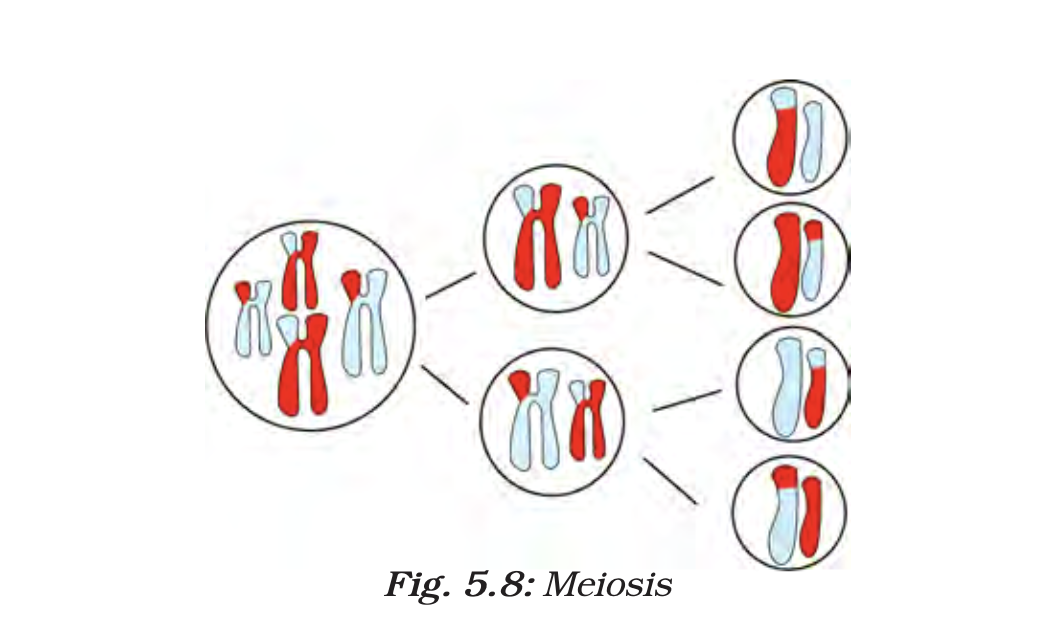
Mitosis - Diagram
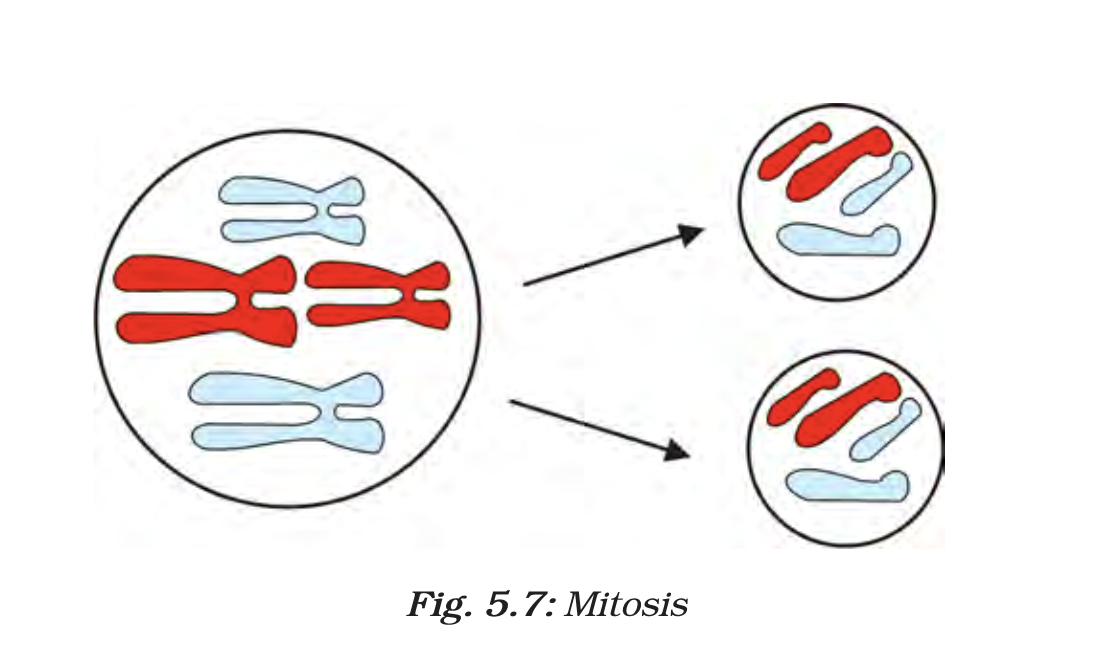
Fundamental unit of life _____
Cell
What is the primary function of leucoplasts
Storage
What does the ER function as?
The ER functions both as a passageway for intracellular transport and as a manufacturing surface. Thus, one function of the ER is to serve as channels for the transport of materials (especially proteins) between various regions of the cytoplasm or between the cytoplasm and the nucleus. The ER also functions as a cytoplasmic framework providing a surface for some of the biochemical activities activities of the cell.
In the liver cells of vertebrates, what role does SER play?
It plays a crucial role in detoxifying many poisons and drugs.
Differentiate between a prokaryotic cell and a eukaryotic cell.
Prokaryotic Cell | Eukaryotic Cell |
|---|---|
Size: generally small | generally large |
Nuclear region poorly defined due to absence of nuclear membrane | Nuclear region: well defined and surrounded by a nuclear membrane |
Chromosome: single | More than one chromosome |
Membrane-bound cell organelles absent | Membrane-bound cell organelles present |